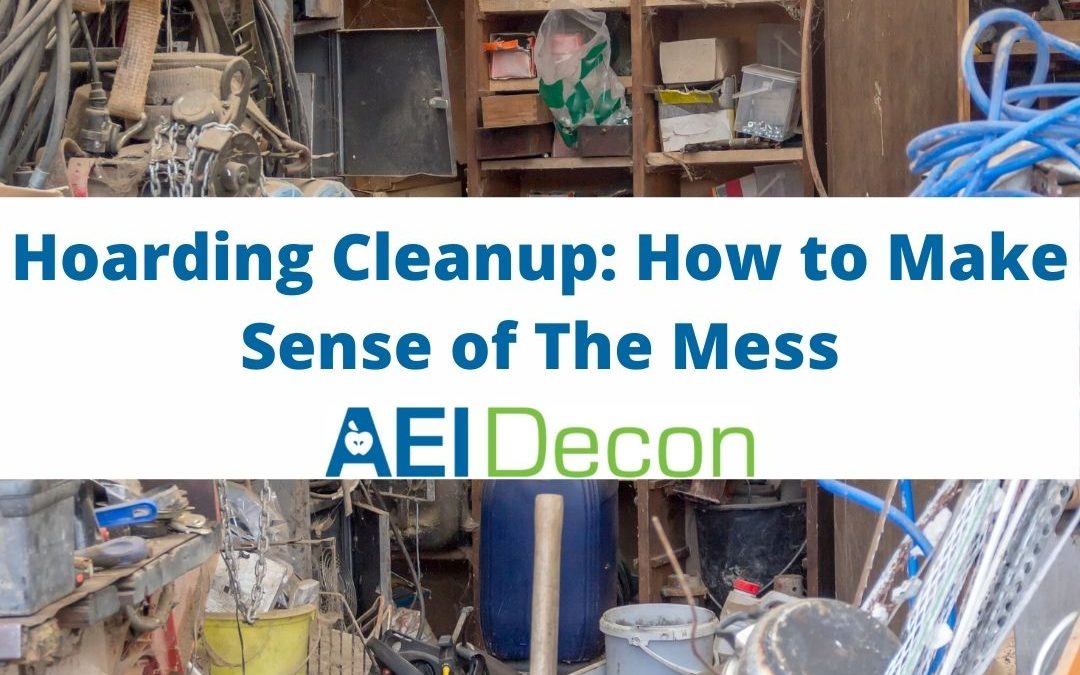Removing items from the property is an intensely challenging experience for most hoarders. In fact, many do not even know how to begin to tackle such an overwhelming project. Over time, this can lead to established patterns of chronic avoidance and denial. Unfortunately, that avoidance won’t solve the problem, leading to homes full of hazards and safety issues.
The good news is that help does exist. From mental health experts to decluttering specialists, there are several approaches you can take to overcome compulsive hoarding. But that doesn’t mean recovery is easy. No, it takes real commitment, high motivation, and (often) the input of trained professionals.
Of course, AEI Decon can’t replace the help of a good therapist. We can, however, share the insights and strategies we’ve gathered as Certified Decontamination Specialists and the many homes we’ve helped rescue from severe hoarding. We hope this can provide some direction in getting started, as well as how to make such a project run more smoothly and compassionately for all involved.
Tips and Strategies for Cleaning A Hoarder House
Planning to Declutter
Before you even touch your belongings, begin by setting SMART and achievable goals. That will break the project into smaller steps and keep you from getting completely overwhelmed. Start with a list of each room and the main objectives for that area. Identify which steps you can take first, on your own, with the greatest efficiency. Which areas can you manage, and where do you need help? (Remember, this is just a general guide, and it works at your pace.) When you have an idea of where you could start, make a game plan that prioritizes creating space first and focuses on repairs later. (Be realistic, work through areas where you struggle with your therapist, and remember—any progress is progress.)
Once you know where you’ll need help, and you’re ready to proceed, plan days when others could assist you. Ask friends or family to pitch in to move trash and items out of your home. Set days for hiring a dumpster, donation pick-ups or drop-offs, holding a yard sale, pulling up carpet, washing walls, etc. (Creating such deadlines can help some individuals stay committed.) And, of course, plan ahead for any big or awkward items you see and do your research about where to dispose of various types of waste.
Create piles your helpers can move without you standing over them. Don’t try to sort every item on a moving day. That will only increase stress and anxiety. Instead, organize piles into sensible categories: such as scrap metal, donations, trash, etc. Remember, you’ll likely need to plan multiple days for these projects and purchase the right safety equipment.
Accessing Emotional Support
Emotional support is important for helping people with hoarding disorder. And yes, we have mentioned we aren’t therapists. So, obviously, we can’t make any concrete recommendations one way or another. However, we have observed a few emotional support strategies in action, and they seem to make a significant difference.
Consider having a person dedicated to your support present on all moving and de-cluttering days. This person may be a therapist, friend, or family member—depending on your needs. They may also need to support you through the initial sorting phases or with allowing others to see your home.
On the other hand, if being present is too challenging, consider the out-of-sight/out-of-mind approach. Some feel it is wiser to step away from the property and engage in a distraction for the day while their friends and family go through the clutter and remove it. Of course, there is usually a trusted point person who oversees this approach, one who can address your needs and plans. Naturally, this strategy isn’t for everyone, but some find it less painful overall.
Again, these ideas come from simple observation and discussion with our customers. So be sure to collaborate with a mental health professional if this is an area of concern.
Seek Alternative Methods of Waste Removal
There are many scenarios where time, finances, and lack of helpers may require you to seek additional assistance. Some situations, too, may expose you to truly hazardous materials. As such, you may want to hire a waste removal or decontamination company. They should be able to help you streamline the process. They will also know the local regulations for the disposal of various substances and objects. Some may even provide services that deal with foul odors, which are often associated with hoarding. That can be a critical necessity for many households, especially those interested in selling the property.
AEI Decon is uniquely positioned to help declutter hoarding homes. Our equipment is unmarked, and we don’t leave a dumpster overnight, so we’re less likely to draw attention than our competitors. We’re also qualified to handle serious contaminants and own our own equipment, making us a more affordable option overall.
However, if all of this is still more than you feel able to handle, consider selling the house as-is. Some investors will purchase low-cost properties and handle the waste removal and decontamination themselves. If you’re located in Utah, we may be able to direct you to a few such investors.
Wherever you are in this process, AEI Decon is happy to provide a free consultation for your next step. Call us today, and we’ll talk you through any questions. (801) 888-6698.

